Cardiovascular Disease Report: Pathophysiology and Recent Findings
VerifiedAdded on 2022/08/18
|16
|4953
|10
Report
AI Summary
This report provides a comprehensive overview of cardiovascular diseases, starting with an introduction to the heart's functions and the impact of unhealthy lifestyles. It delves into the pathophysiology of the disease, explaining the role of atherosclerosis, inflammation, and oxidative processes. The report outlines both modifiable and non-modifiable risk factors, including dietary habits, obesity, age, and genetics, and describes the symptoms and diagnostic procedures used to identify various cardiovascular conditions. Furthermore, it explores recent findings and technological advancements, such as the fat radiomic profile and bio-resorbable stents, offering insights into the latest developments in the field and their potential impact on treatment and management of cardiovascular diseases. The report covers the different types of cardiovascular diseases, their causes, symptoms and different types of diagnostic procedures.
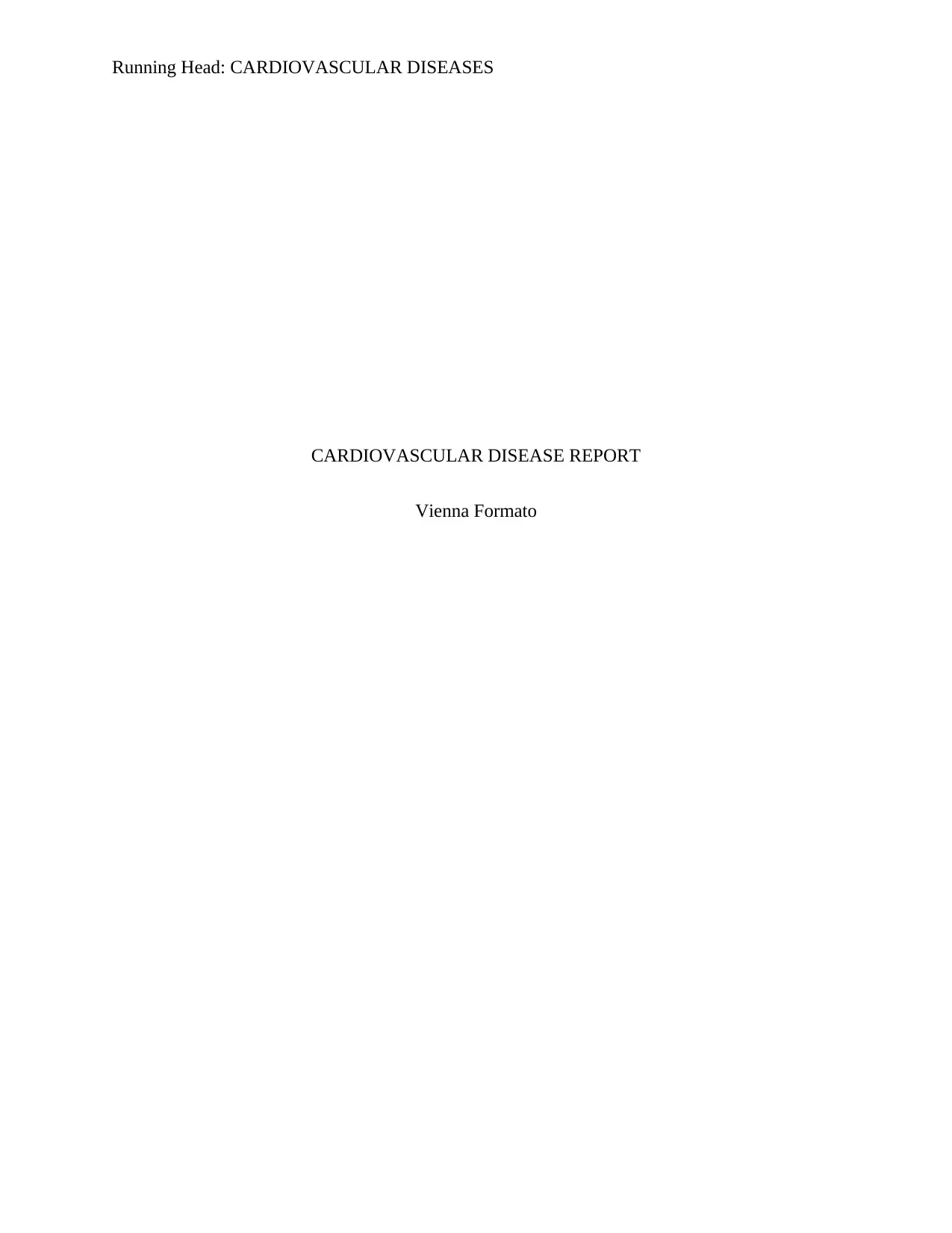
Running Head: CARDIOVASCULAR DISEASES
CARDIOVASCULAR DISEASE REPORT
Vienna Formato
CARDIOVASCULAR DISEASE REPORT
Vienna Formato
Paraphrase This Document
Need a fresh take? Get an instant paraphrase of this document with our AI Paraphraser
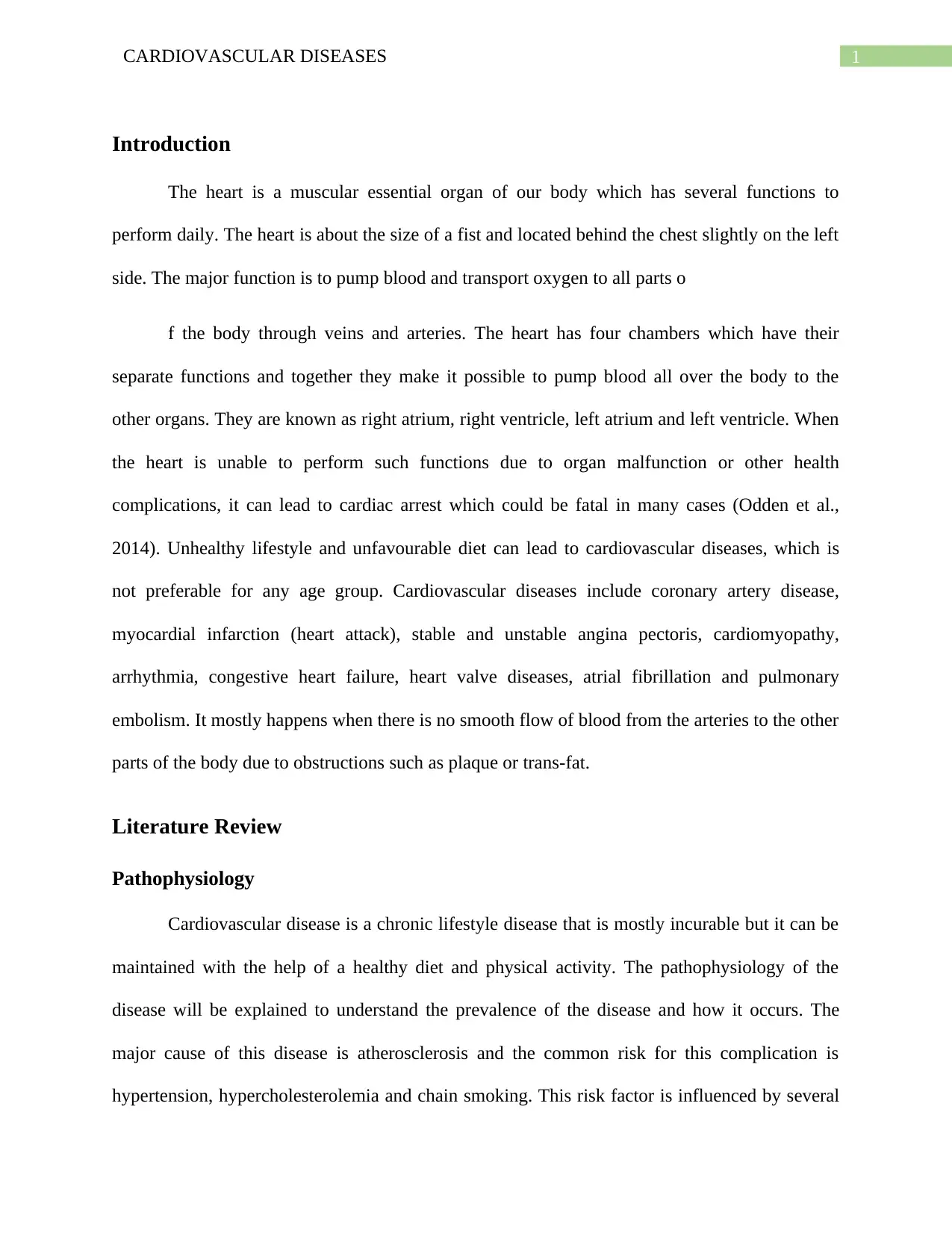
1CARDIOVASCULAR DISEASES
Introduction
The heart is a muscular essential organ of our body which has several functions to
perform daily. The heart is about the size of a fist and located behind the chest slightly on the left
side. The major function is to pump blood and transport oxygen to all parts o
f the body through veins and arteries. The heart has four chambers which have their
separate functions and together they make it possible to pump blood all over the body to the
other organs. They are known as right atrium, right ventricle, left atrium and left ventricle. When
the heart is unable to perform such functions due to organ malfunction or other health
complications, it can lead to cardiac arrest which could be fatal in many cases (Odden et al.,
2014). Unhealthy lifestyle and unfavourable diet can lead to cardiovascular diseases, which is
not preferable for any age group. Cardiovascular diseases include coronary artery disease,
myocardial infarction (heart attack), stable and unstable angina pectoris, cardiomyopathy,
arrhythmia, congestive heart failure, heart valve diseases, atrial fibrillation and pulmonary
embolism. It mostly happens when there is no smooth flow of blood from the arteries to the other
parts of the body due to obstructions such as plaque or trans-fat.
Literature Review
Pathophysiology
Cardiovascular disease is a chronic lifestyle disease that is mostly incurable but it can be
maintained with the help of a healthy diet and physical activity. The pathophysiology of the
disease will be explained to understand the prevalence of the disease and how it occurs. The
major cause of this disease is atherosclerosis and the common risk for this complication is
hypertension, hypercholesterolemia and chain smoking. This risk factor is influenced by several
Introduction
The heart is a muscular essential organ of our body which has several functions to
perform daily. The heart is about the size of a fist and located behind the chest slightly on the left
side. The major function is to pump blood and transport oxygen to all parts o
f the body through veins and arteries. The heart has four chambers which have their
separate functions and together they make it possible to pump blood all over the body to the
other organs. They are known as right atrium, right ventricle, left atrium and left ventricle. When
the heart is unable to perform such functions due to organ malfunction or other health
complications, it can lead to cardiac arrest which could be fatal in many cases (Odden et al.,
2014). Unhealthy lifestyle and unfavourable diet can lead to cardiovascular diseases, which is
not preferable for any age group. Cardiovascular diseases include coronary artery disease,
myocardial infarction (heart attack), stable and unstable angina pectoris, cardiomyopathy,
arrhythmia, congestive heart failure, heart valve diseases, atrial fibrillation and pulmonary
embolism. It mostly happens when there is no smooth flow of blood from the arteries to the other
parts of the body due to obstructions such as plaque or trans-fat.
Literature Review
Pathophysiology
Cardiovascular disease is a chronic lifestyle disease that is mostly incurable but it can be
maintained with the help of a healthy diet and physical activity. The pathophysiology of the
disease will be explained to understand the prevalence of the disease and how it occurs. The
major cause of this disease is atherosclerosis and the common risk for this complication is
hypertension, hypercholesterolemia and chain smoking. This risk factor is influenced by several
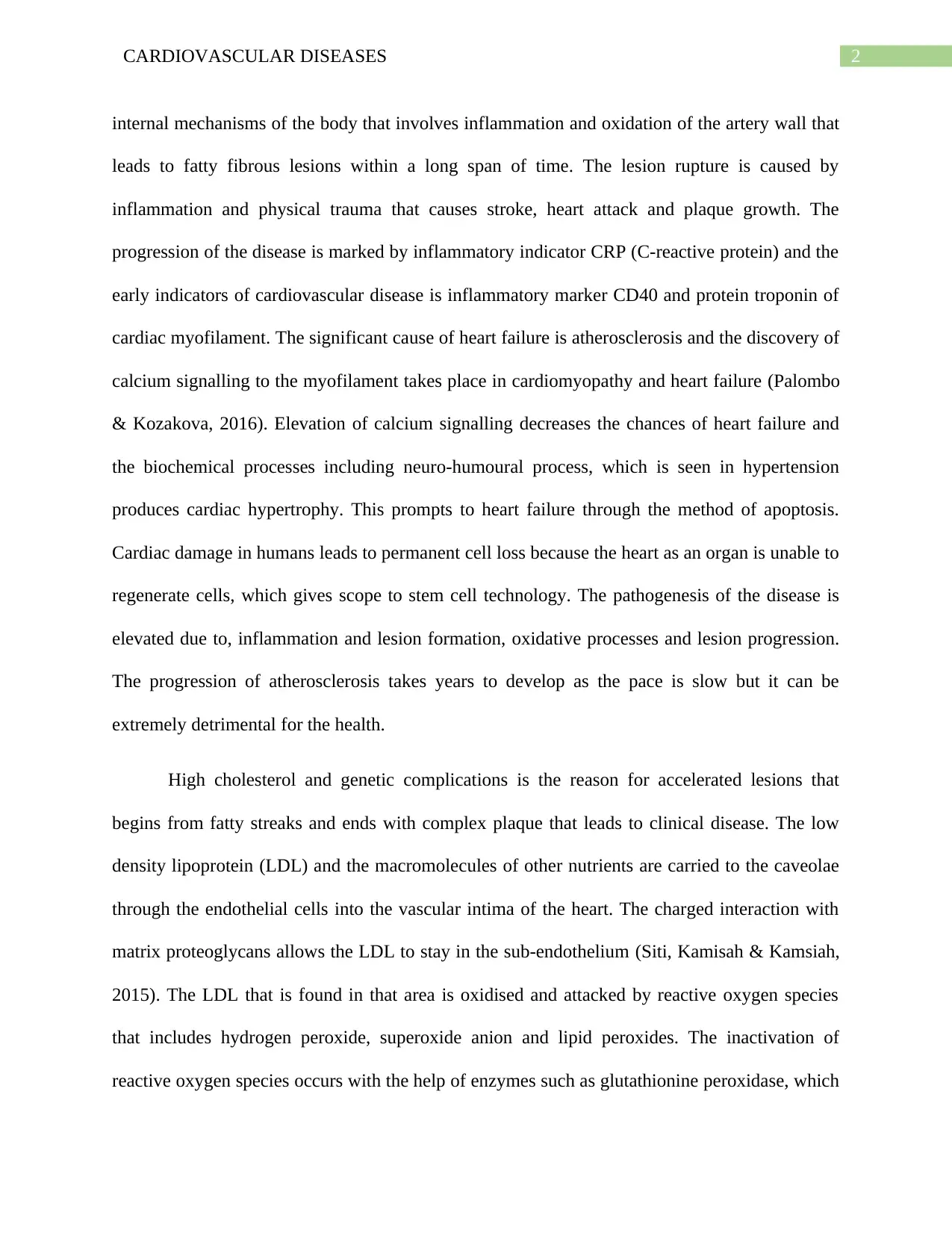
2CARDIOVASCULAR DISEASES
internal mechanisms of the body that involves inflammation and oxidation of the artery wall that
leads to fatty fibrous lesions within a long span of time. The lesion rupture is caused by
inflammation and physical trauma that causes stroke, heart attack and plaque growth. The
progression of the disease is marked by inflammatory indicator CRP (C-reactive protein) and the
early indicators of cardiovascular disease is inflammatory marker CD40 and protein troponin of
cardiac myofilament. The significant cause of heart failure is atherosclerosis and the discovery of
calcium signalling to the myofilament takes place in cardiomyopathy and heart failure (Palombo
& Kozakova, 2016). Elevation of calcium signalling decreases the chances of heart failure and
the biochemical processes including neuro-humoural process, which is seen in hypertension
produces cardiac hypertrophy. This prompts to heart failure through the method of apoptosis.
Cardiac damage in humans leads to permanent cell loss because the heart as an organ is unable to
regenerate cells, which gives scope to stem cell technology. The pathogenesis of the disease is
elevated due to, inflammation and lesion formation, oxidative processes and lesion progression.
The progression of atherosclerosis takes years to develop as the pace is slow but it can be
extremely detrimental for the health.
High cholesterol and genetic complications is the reason for accelerated lesions that
begins from fatty streaks and ends with complex plaque that leads to clinical disease. The low
density lipoprotein (LDL) and the macromolecules of other nutrients are carried to the caveolae
through the endothelial cells into the vascular intima of the heart. The charged interaction with
matrix proteoglycans allows the LDL to stay in the sub-endothelium (Siti, Kamisah & Kamsiah,
2015). The LDL that is found in that area is oxidised and attacked by reactive oxygen species
that includes hydrogen peroxide, superoxide anion and lipid peroxides. The inactivation of
reactive oxygen species occurs with the help of enzymes such as glutathionine peroxidase, which
internal mechanisms of the body that involves inflammation and oxidation of the artery wall that
leads to fatty fibrous lesions within a long span of time. The lesion rupture is caused by
inflammation and physical trauma that causes stroke, heart attack and plaque growth. The
progression of the disease is marked by inflammatory indicator CRP (C-reactive protein) and the
early indicators of cardiovascular disease is inflammatory marker CD40 and protein troponin of
cardiac myofilament. The significant cause of heart failure is atherosclerosis and the discovery of
calcium signalling to the myofilament takes place in cardiomyopathy and heart failure (Palombo
& Kozakova, 2016). Elevation of calcium signalling decreases the chances of heart failure and
the biochemical processes including neuro-humoural process, which is seen in hypertension
produces cardiac hypertrophy. This prompts to heart failure through the method of apoptosis.
Cardiac damage in humans leads to permanent cell loss because the heart as an organ is unable to
regenerate cells, which gives scope to stem cell technology. The pathogenesis of the disease is
elevated due to, inflammation and lesion formation, oxidative processes and lesion progression.
The progression of atherosclerosis takes years to develop as the pace is slow but it can be
extremely detrimental for the health.
High cholesterol and genetic complications is the reason for accelerated lesions that
begins from fatty streaks and ends with complex plaque that leads to clinical disease. The low
density lipoprotein (LDL) and the macromolecules of other nutrients are carried to the caveolae
through the endothelial cells into the vascular intima of the heart. The charged interaction with
matrix proteoglycans allows the LDL to stay in the sub-endothelium (Siti, Kamisah & Kamsiah,
2015). The LDL that is found in that area is oxidised and attacked by reactive oxygen species
that includes hydrogen peroxide, superoxide anion and lipid peroxides. The inactivation of
reactive oxygen species occurs with the help of enzymes such as glutathionine peroxidase, which
⊘ This is a preview!⊘
Do you want full access?
Subscribe today to unlock all pages.

Trusted by 1+ million students worldwide
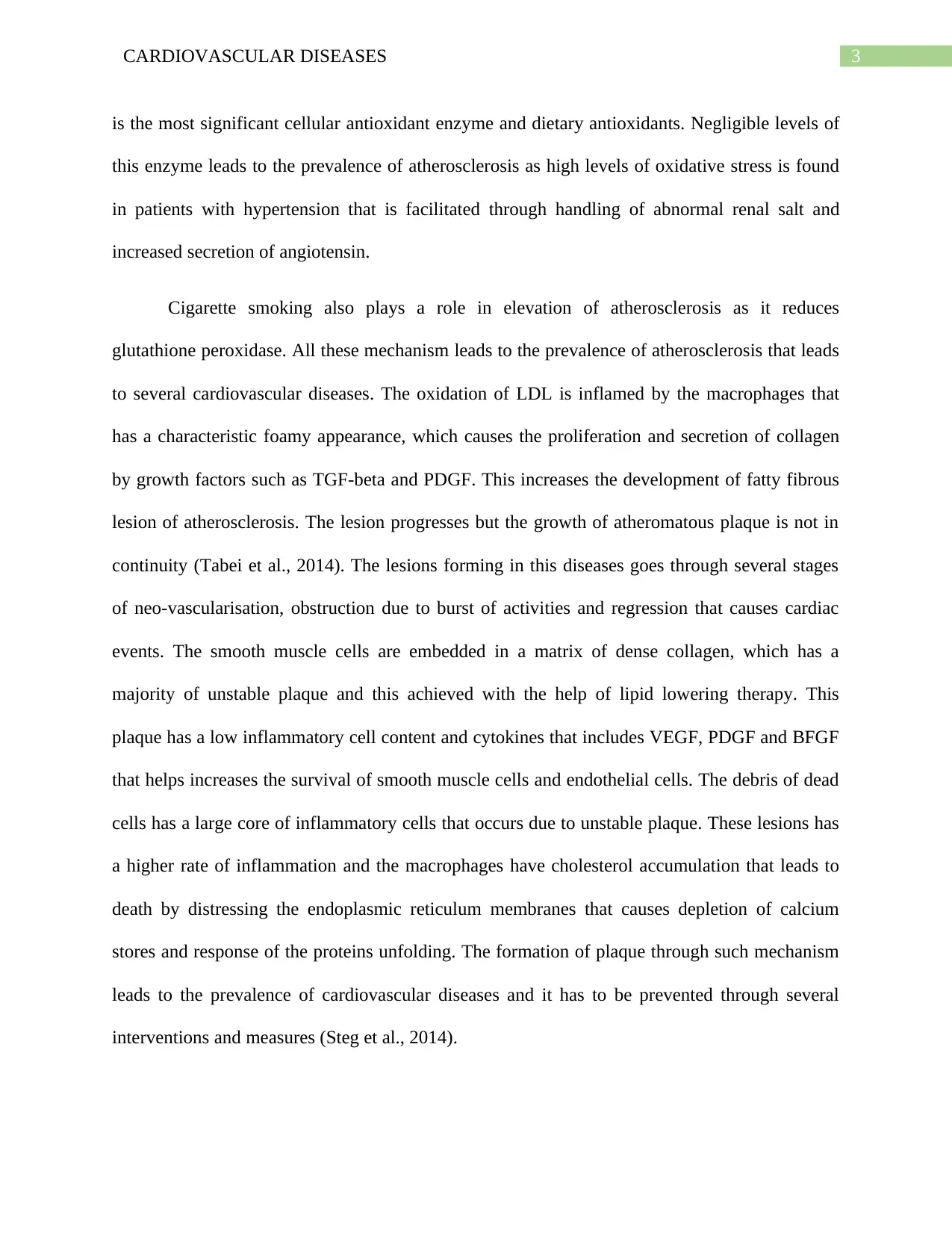
3CARDIOVASCULAR DISEASES
is the most significant cellular antioxidant enzyme and dietary antioxidants. Negligible levels of
this enzyme leads to the prevalence of atherosclerosis as high levels of oxidative stress is found
in patients with hypertension that is facilitated through handling of abnormal renal salt and
increased secretion of angiotensin.
Cigarette smoking also plays a role in elevation of atherosclerosis as it reduces
glutathione peroxidase. All these mechanism leads to the prevalence of atherosclerosis that leads
to several cardiovascular diseases. The oxidation of LDL is inflamed by the macrophages that
has a characteristic foamy appearance, which causes the proliferation and secretion of collagen
by growth factors such as TGF-beta and PDGF. This increases the development of fatty fibrous
lesion of atherosclerosis. The lesion progresses but the growth of atheromatous plaque is not in
continuity (Tabei et al., 2014). The lesions forming in this diseases goes through several stages
of neo-vascularisation, obstruction due to burst of activities and regression that causes cardiac
events. The smooth muscle cells are embedded in a matrix of dense collagen, which has a
majority of unstable plaque and this achieved with the help of lipid lowering therapy. This
plaque has a low inflammatory cell content and cytokines that includes VEGF, PDGF and BFGF
that helps increases the survival of smooth muscle cells and endothelial cells. The debris of dead
cells has a large core of inflammatory cells that occurs due to unstable plaque. These lesions has
a higher rate of inflammation and the macrophages have cholesterol accumulation that leads to
death by distressing the endoplasmic reticulum membranes that causes depletion of calcium
stores and response of the proteins unfolding. The formation of plaque through such mechanism
leads to the prevalence of cardiovascular diseases and it has to be prevented through several
interventions and measures (Steg et al., 2014).
is the most significant cellular antioxidant enzyme and dietary antioxidants. Negligible levels of
this enzyme leads to the prevalence of atherosclerosis as high levels of oxidative stress is found
in patients with hypertension that is facilitated through handling of abnormal renal salt and
increased secretion of angiotensin.
Cigarette smoking also plays a role in elevation of atherosclerosis as it reduces
glutathione peroxidase. All these mechanism leads to the prevalence of atherosclerosis that leads
to several cardiovascular diseases. The oxidation of LDL is inflamed by the macrophages that
has a characteristic foamy appearance, which causes the proliferation and secretion of collagen
by growth factors such as TGF-beta and PDGF. This increases the development of fatty fibrous
lesion of atherosclerosis. The lesion progresses but the growth of atheromatous plaque is not in
continuity (Tabei et al., 2014). The lesions forming in this diseases goes through several stages
of neo-vascularisation, obstruction due to burst of activities and regression that causes cardiac
events. The smooth muscle cells are embedded in a matrix of dense collagen, which has a
majority of unstable plaque and this achieved with the help of lipid lowering therapy. This
plaque has a low inflammatory cell content and cytokines that includes VEGF, PDGF and BFGF
that helps increases the survival of smooth muscle cells and endothelial cells. The debris of dead
cells has a large core of inflammatory cells that occurs due to unstable plaque. These lesions has
a higher rate of inflammation and the macrophages have cholesterol accumulation that leads to
death by distressing the endoplasmic reticulum membranes that causes depletion of calcium
stores and response of the proteins unfolding. The formation of plaque through such mechanism
leads to the prevalence of cardiovascular diseases and it has to be prevented through several
interventions and measures (Steg et al., 2014).
Paraphrase This Document
Need a fresh take? Get an instant paraphrase of this document with our AI Paraphraser
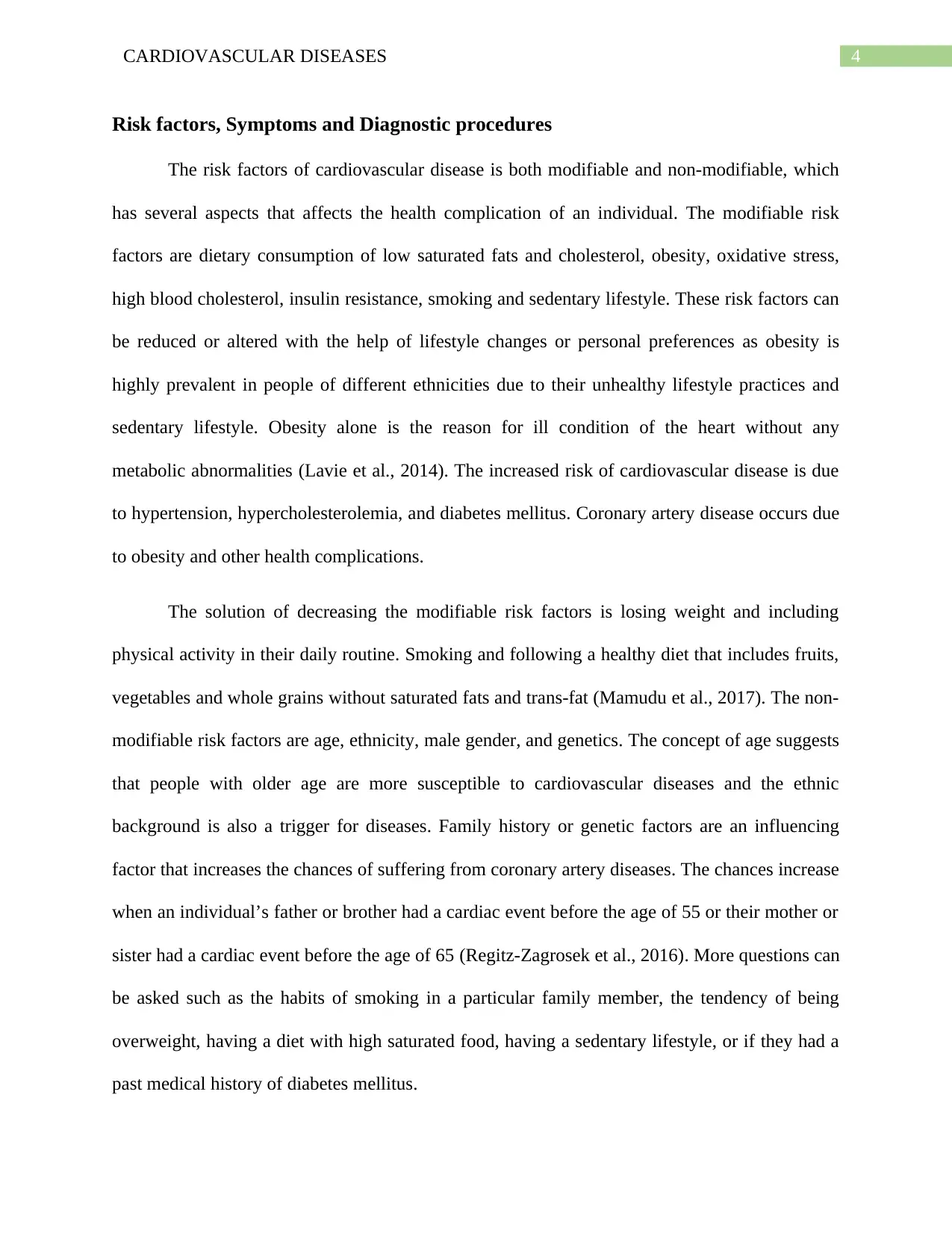
4CARDIOVASCULAR DISEASES
Risk factors, Symptoms and Diagnostic procedures
The risk factors of cardiovascular disease is both modifiable and non-modifiable, which
has several aspects that affects the health complication of an individual. The modifiable risk
factors are dietary consumption of low saturated fats and cholesterol, obesity, oxidative stress,
high blood cholesterol, insulin resistance, smoking and sedentary lifestyle. These risk factors can
be reduced or altered with the help of lifestyle changes or personal preferences as obesity is
highly prevalent in people of different ethnicities due to their unhealthy lifestyle practices and
sedentary lifestyle. Obesity alone is the reason for ill condition of the heart without any
metabolic abnormalities (Lavie et al., 2014). The increased risk of cardiovascular disease is due
to hypertension, hypercholesterolemia, and diabetes mellitus. Coronary artery disease occurs due
to obesity and other health complications.
The solution of decreasing the modifiable risk factors is losing weight and including
physical activity in their daily routine. Smoking and following a healthy diet that includes fruits,
vegetables and whole grains without saturated fats and trans-fat (Mamudu et al., 2017). The non-
modifiable risk factors are age, ethnicity, male gender, and genetics. The concept of age suggests
that people with older age are more susceptible to cardiovascular diseases and the ethnic
background is also a trigger for diseases. Family history or genetic factors are an influencing
factor that increases the chances of suffering from coronary artery diseases. The chances increase
when an individual’s father or brother had a cardiac event before the age of 55 or their mother or
sister had a cardiac event before the age of 65 (Regitz-Zagrosek et al., 2016). More questions can
be asked such as the habits of smoking in a particular family member, the tendency of being
overweight, having a diet with high saturated food, having a sedentary lifestyle, or if they had a
past medical history of diabetes mellitus.
Risk factors, Symptoms and Diagnostic procedures
The risk factors of cardiovascular disease is both modifiable and non-modifiable, which
has several aspects that affects the health complication of an individual. The modifiable risk
factors are dietary consumption of low saturated fats and cholesterol, obesity, oxidative stress,
high blood cholesterol, insulin resistance, smoking and sedentary lifestyle. These risk factors can
be reduced or altered with the help of lifestyle changes or personal preferences as obesity is
highly prevalent in people of different ethnicities due to their unhealthy lifestyle practices and
sedentary lifestyle. Obesity alone is the reason for ill condition of the heart without any
metabolic abnormalities (Lavie et al., 2014). The increased risk of cardiovascular disease is due
to hypertension, hypercholesterolemia, and diabetes mellitus. Coronary artery disease occurs due
to obesity and other health complications.
The solution of decreasing the modifiable risk factors is losing weight and including
physical activity in their daily routine. Smoking and following a healthy diet that includes fruits,
vegetables and whole grains without saturated fats and trans-fat (Mamudu et al., 2017). The non-
modifiable risk factors are age, ethnicity, male gender, and genetics. The concept of age suggests
that people with older age are more susceptible to cardiovascular diseases and the ethnic
background is also a trigger for diseases. Family history or genetic factors are an influencing
factor that increases the chances of suffering from coronary artery diseases. The chances increase
when an individual’s father or brother had a cardiac event before the age of 55 or their mother or
sister had a cardiac event before the age of 65 (Regitz-Zagrosek et al., 2016). More questions can
be asked such as the habits of smoking in a particular family member, the tendency of being
overweight, having a diet with high saturated food, having a sedentary lifestyle, or if they had a
past medical history of diabetes mellitus.
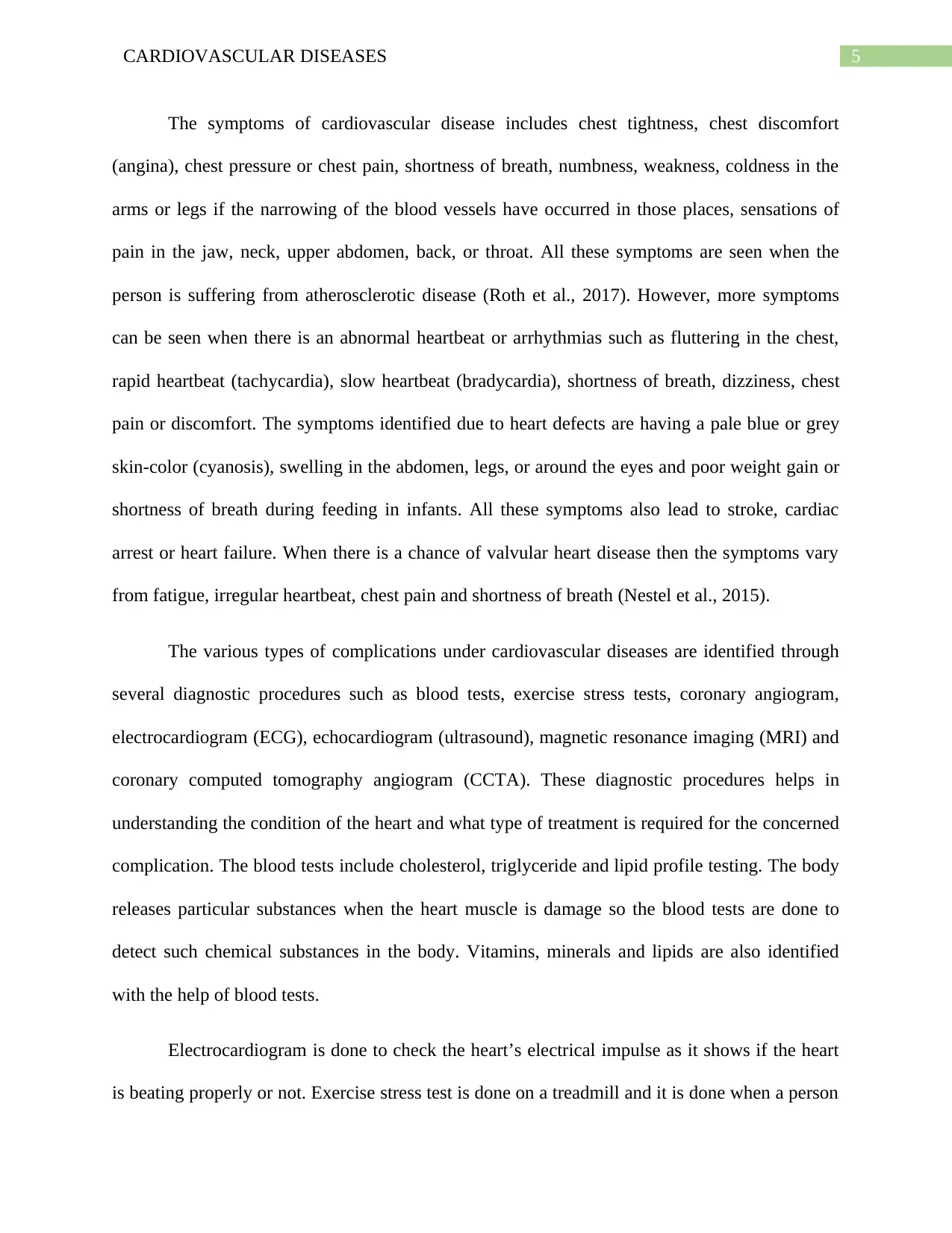
5CARDIOVASCULAR DISEASES
The symptoms of cardiovascular disease includes chest tightness, chest discomfort
(angina), chest pressure or chest pain, shortness of breath, numbness, weakness, coldness in the
arms or legs if the narrowing of the blood vessels have occurred in those places, sensations of
pain in the jaw, neck, upper abdomen, back, or throat. All these symptoms are seen when the
person is suffering from atherosclerotic disease (Roth et al., 2017). However, more symptoms
can be seen when there is an abnormal heartbeat or arrhythmias such as fluttering in the chest,
rapid heartbeat (tachycardia), slow heartbeat (bradycardia), shortness of breath, dizziness, chest
pain or discomfort. The symptoms identified due to heart defects are having a pale blue or grey
skin-color (cyanosis), swelling in the abdomen, legs, or around the eyes and poor weight gain or
shortness of breath during feeding in infants. All these symptoms also lead to stroke, cardiac
arrest or heart failure. When there is a chance of valvular heart disease then the symptoms vary
from fatigue, irregular heartbeat, chest pain and shortness of breath (Nestel et al., 2015).
The various types of complications under cardiovascular diseases are identified through
several diagnostic procedures such as blood tests, exercise stress tests, coronary angiogram,
electrocardiogram (ECG), echocardiogram (ultrasound), magnetic resonance imaging (MRI) and
coronary computed tomography angiogram (CCTA). These diagnostic procedures helps in
understanding the condition of the heart and what type of treatment is required for the concerned
complication. The blood tests include cholesterol, triglyceride and lipid profile testing. The body
releases particular substances when the heart muscle is damage so the blood tests are done to
detect such chemical substances in the body. Vitamins, minerals and lipids are also identified
with the help of blood tests.
Electrocardiogram is done to check the heart’s electrical impulse as it shows if the heart
is beating properly or not. Exercise stress test is done on a treadmill and it is done when a person
The symptoms of cardiovascular disease includes chest tightness, chest discomfort
(angina), chest pressure or chest pain, shortness of breath, numbness, weakness, coldness in the
arms or legs if the narrowing of the blood vessels have occurred in those places, sensations of
pain in the jaw, neck, upper abdomen, back, or throat. All these symptoms are seen when the
person is suffering from atherosclerotic disease (Roth et al., 2017). However, more symptoms
can be seen when there is an abnormal heartbeat or arrhythmias such as fluttering in the chest,
rapid heartbeat (tachycardia), slow heartbeat (bradycardia), shortness of breath, dizziness, chest
pain or discomfort. The symptoms identified due to heart defects are having a pale blue or grey
skin-color (cyanosis), swelling in the abdomen, legs, or around the eyes and poor weight gain or
shortness of breath during feeding in infants. All these symptoms also lead to stroke, cardiac
arrest or heart failure. When there is a chance of valvular heart disease then the symptoms vary
from fatigue, irregular heartbeat, chest pain and shortness of breath (Nestel et al., 2015).
The various types of complications under cardiovascular diseases are identified through
several diagnostic procedures such as blood tests, exercise stress tests, coronary angiogram,
electrocardiogram (ECG), echocardiogram (ultrasound), magnetic resonance imaging (MRI) and
coronary computed tomography angiogram (CCTA). These diagnostic procedures helps in
understanding the condition of the heart and what type of treatment is required for the concerned
complication. The blood tests include cholesterol, triglyceride and lipid profile testing. The body
releases particular substances when the heart muscle is damage so the blood tests are done to
detect such chemical substances in the body. Vitamins, minerals and lipids are also identified
with the help of blood tests.
Electrocardiogram is done to check the heart’s electrical impulse as it shows if the heart
is beating properly or not. Exercise stress test is done on a treadmill and it is done when a person
⊘ This is a preview!⊘
Do you want full access?
Subscribe today to unlock all pages.

Trusted by 1+ million students worldwide
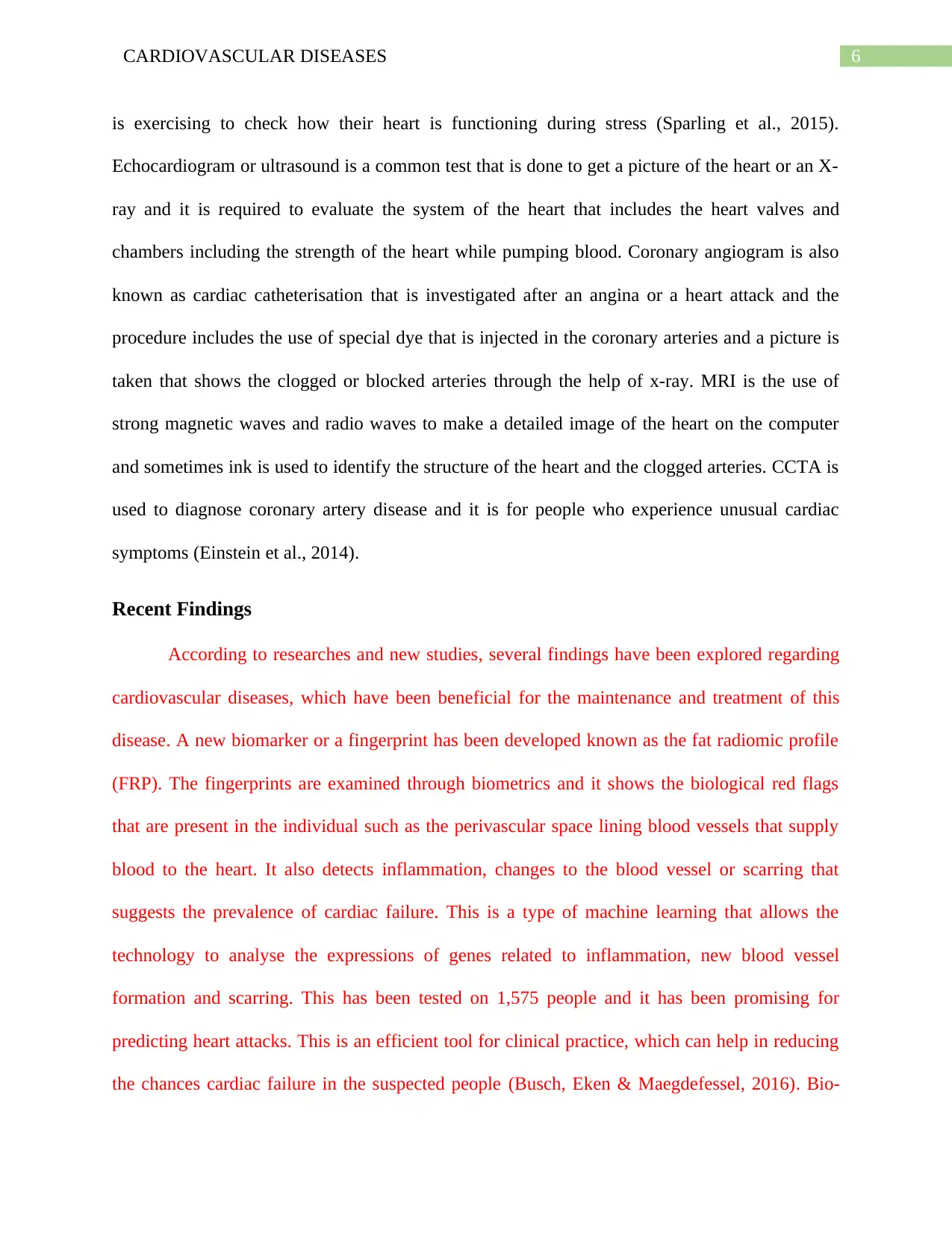
6CARDIOVASCULAR DISEASES
is exercising to check how their heart is functioning during stress (Sparling et al., 2015).
Echocardiogram or ultrasound is a common test that is done to get a picture of the heart or an X-
ray and it is required to evaluate the system of the heart that includes the heart valves and
chambers including the strength of the heart while pumping blood. Coronary angiogram is also
known as cardiac catheterisation that is investigated after an angina or a heart attack and the
procedure includes the use of special dye that is injected in the coronary arteries and a picture is
taken that shows the clogged or blocked arteries through the help of x-ray. MRI is the use of
strong magnetic waves and radio waves to make a detailed image of the heart on the computer
and sometimes ink is used to identify the structure of the heart and the clogged arteries. CCTA is
used to diagnose coronary artery disease and it is for people who experience unusual cardiac
symptoms (Einstein et al., 2014).
Recent Findings
According to researches and new studies, several findings have been explored regarding
cardiovascular diseases, which have been beneficial for the maintenance and treatment of this
disease. A new biomarker or a fingerprint has been developed known as the fat radiomic profile
(FRP). The fingerprints are examined through biometrics and it shows the biological red flags
that are present in the individual such as the perivascular space lining blood vessels that supply
blood to the heart. It also detects inflammation, changes to the blood vessel or scarring that
suggests the prevalence of cardiac failure. This is a type of machine learning that allows the
technology to analyse the expressions of genes related to inflammation, new blood vessel
formation and scarring. This has been tested on 1,575 people and it has been promising for
predicting heart attacks. This is an efficient tool for clinical practice, which can help in reducing
the chances cardiac failure in the suspected people (Busch, Eken & Maegdefessel, 2016). Bio-
is exercising to check how their heart is functioning during stress (Sparling et al., 2015).
Echocardiogram or ultrasound is a common test that is done to get a picture of the heart or an X-
ray and it is required to evaluate the system of the heart that includes the heart valves and
chambers including the strength of the heart while pumping blood. Coronary angiogram is also
known as cardiac catheterisation that is investigated after an angina or a heart attack and the
procedure includes the use of special dye that is injected in the coronary arteries and a picture is
taken that shows the clogged or blocked arteries through the help of x-ray. MRI is the use of
strong magnetic waves and radio waves to make a detailed image of the heart on the computer
and sometimes ink is used to identify the structure of the heart and the clogged arteries. CCTA is
used to diagnose coronary artery disease and it is for people who experience unusual cardiac
symptoms (Einstein et al., 2014).
Recent Findings
According to researches and new studies, several findings have been explored regarding
cardiovascular diseases, which have been beneficial for the maintenance and treatment of this
disease. A new biomarker or a fingerprint has been developed known as the fat radiomic profile
(FRP). The fingerprints are examined through biometrics and it shows the biological red flags
that are present in the individual such as the perivascular space lining blood vessels that supply
blood to the heart. It also detects inflammation, changes to the blood vessel or scarring that
suggests the prevalence of cardiac failure. This is a type of machine learning that allows the
technology to analyse the expressions of genes related to inflammation, new blood vessel
formation and scarring. This has been tested on 1,575 people and it has been promising for
predicting heart attacks. This is an efficient tool for clinical practice, which can help in reducing
the chances cardiac failure in the suspected people (Busch, Eken & Maegdefessel, 2016). Bio-
Paraphrase This Document
Need a fresh take? Get an instant paraphrase of this document with our AI Paraphraser
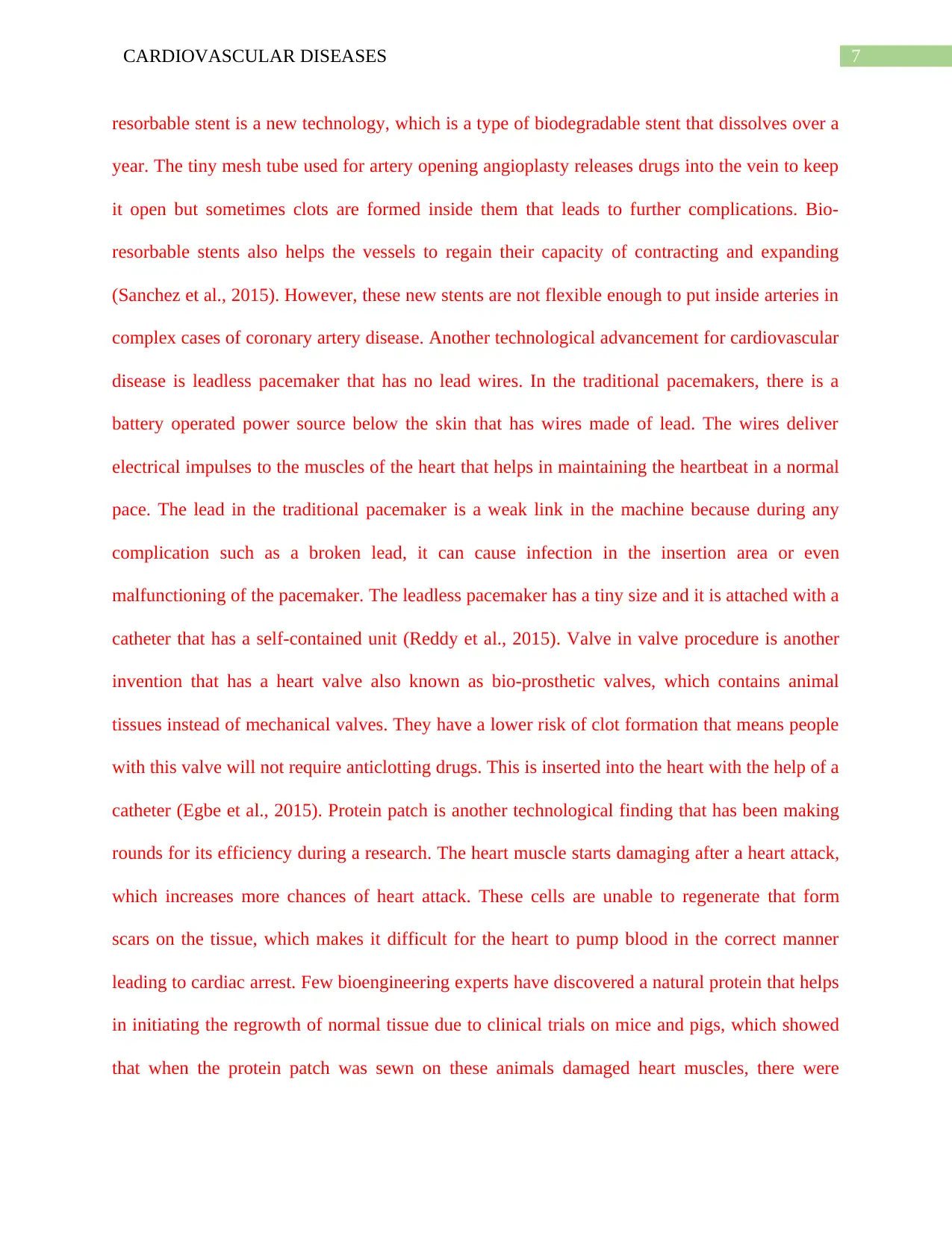
7CARDIOVASCULAR DISEASES
resorbable stent is a new technology, which is a type of biodegradable stent that dissolves over a
year. The tiny mesh tube used for artery opening angioplasty releases drugs into the vein to keep
it open but sometimes clots are formed inside them that leads to further complications. Bio-
resorbable stents also helps the vessels to regain their capacity of contracting and expanding
(Sanchez et al., 2015). However, these new stents are not flexible enough to put inside arteries in
complex cases of coronary artery disease. Another technological advancement for cardiovascular
disease is leadless pacemaker that has no lead wires. In the traditional pacemakers, there is a
battery operated power source below the skin that has wires made of lead. The wires deliver
electrical impulses to the muscles of the heart that helps in maintaining the heartbeat in a normal
pace. The lead in the traditional pacemaker is a weak link in the machine because during any
complication such as a broken lead, it can cause infection in the insertion area or even
malfunctioning of the pacemaker. The leadless pacemaker has a tiny size and it is attached with a
catheter that has a self-contained unit (Reddy et al., 2015). Valve in valve procedure is another
invention that has a heart valve also known as bio-prosthetic valves, which contains animal
tissues instead of mechanical valves. They have a lower risk of clot formation that means people
with this valve will not require anticlotting drugs. This is inserted into the heart with the help of a
catheter (Egbe et al., 2015). Protein patch is another technological finding that has been making
rounds for its efficiency during a research. The heart muscle starts damaging after a heart attack,
which increases more chances of heart attack. These cells are unable to regenerate that form
scars on the tissue, which makes it difficult for the heart to pump blood in the correct manner
leading to cardiac arrest. Few bioengineering experts have discovered a natural protein that helps
in initiating the regrowth of normal tissue due to clinical trials on mice and pigs, which showed
that when the protein patch was sewn on these animals damaged heart muscles, there were
resorbable stent is a new technology, which is a type of biodegradable stent that dissolves over a
year. The tiny mesh tube used for artery opening angioplasty releases drugs into the vein to keep
it open but sometimes clots are formed inside them that leads to further complications. Bio-
resorbable stents also helps the vessels to regain their capacity of contracting and expanding
(Sanchez et al., 2015). However, these new stents are not flexible enough to put inside arteries in
complex cases of coronary artery disease. Another technological advancement for cardiovascular
disease is leadless pacemaker that has no lead wires. In the traditional pacemakers, there is a
battery operated power source below the skin that has wires made of lead. The wires deliver
electrical impulses to the muscles of the heart that helps in maintaining the heartbeat in a normal
pace. The lead in the traditional pacemaker is a weak link in the machine because during any
complication such as a broken lead, it can cause infection in the insertion area or even
malfunctioning of the pacemaker. The leadless pacemaker has a tiny size and it is attached with a
catheter that has a self-contained unit (Reddy et al., 2015). Valve in valve procedure is another
invention that has a heart valve also known as bio-prosthetic valves, which contains animal
tissues instead of mechanical valves. They have a lower risk of clot formation that means people
with this valve will not require anticlotting drugs. This is inserted into the heart with the help of a
catheter (Egbe et al., 2015). Protein patch is another technological finding that has been making
rounds for its efficiency during a research. The heart muscle starts damaging after a heart attack,
which increases more chances of heart attack. These cells are unable to regenerate that form
scars on the tissue, which makes it difficult for the heart to pump blood in the correct manner
leading to cardiac arrest. Few bioengineering experts have discovered a natural protein that helps
in initiating the regrowth of normal tissue due to clinical trials on mice and pigs, which showed
that when the protein patch was sewn on these animals damaged heart muscles, there were
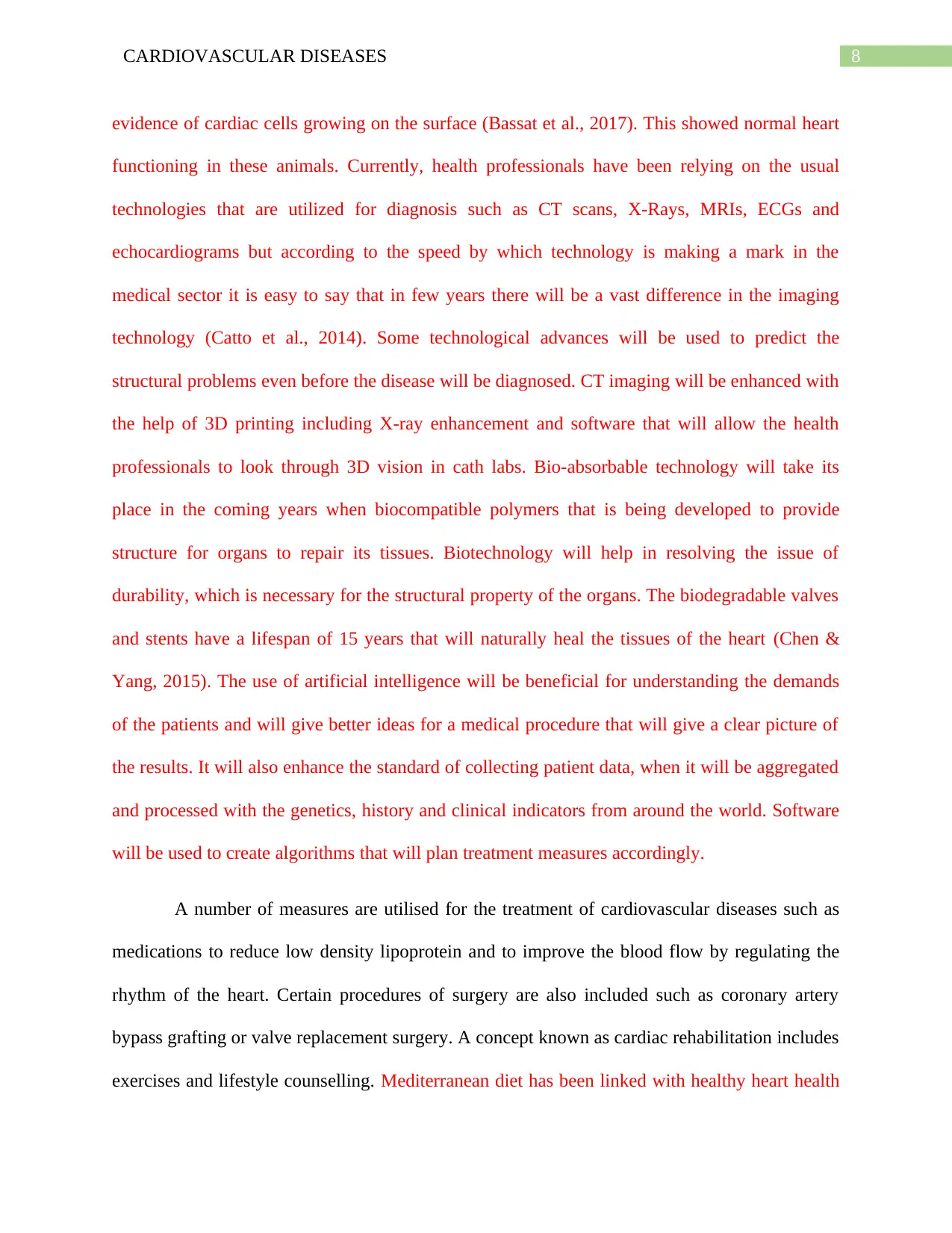
8CARDIOVASCULAR DISEASES
evidence of cardiac cells growing on the surface (Bassat et al., 2017). This showed normal heart
functioning in these animals. Currently, health professionals have been relying on the usual
technologies that are utilized for diagnosis such as CT scans, X-Rays, MRIs, ECGs and
echocardiograms but according to the speed by which technology is making a mark in the
medical sector it is easy to say that in few years there will be a vast difference in the imaging
technology (Catto et al., 2014). Some technological advances will be used to predict the
structural problems even before the disease will be diagnosed. CT imaging will be enhanced with
the help of 3D printing including X-ray enhancement and software that will allow the health
professionals to look through 3D vision in cath labs. Bio-absorbable technology will take its
place in the coming years when biocompatible polymers that is being developed to provide
structure for organs to repair its tissues. Biotechnology will help in resolving the issue of
durability, which is necessary for the structural property of the organs. The biodegradable valves
and stents have a lifespan of 15 years that will naturally heal the tissues of the heart (Chen &
Yang, 2015). The use of artificial intelligence will be beneficial for understanding the demands
of the patients and will give better ideas for a medical procedure that will give a clear picture of
the results. It will also enhance the standard of collecting patient data, when it will be aggregated
and processed with the genetics, history and clinical indicators from around the world. Software
will be used to create algorithms that will plan treatment measures accordingly.
A number of measures are utilised for the treatment of cardiovascular diseases such as
medications to reduce low density lipoprotein and to improve the blood flow by regulating the
rhythm of the heart. Certain procedures of surgery are also included such as coronary artery
bypass grafting or valve replacement surgery. A concept known as cardiac rehabilitation includes
exercises and lifestyle counselling. Mediterranean diet has been linked with healthy heart health
evidence of cardiac cells growing on the surface (Bassat et al., 2017). This showed normal heart
functioning in these animals. Currently, health professionals have been relying on the usual
technologies that are utilized for diagnosis such as CT scans, X-Rays, MRIs, ECGs and
echocardiograms but according to the speed by which technology is making a mark in the
medical sector it is easy to say that in few years there will be a vast difference in the imaging
technology (Catto et al., 2014). Some technological advances will be used to predict the
structural problems even before the disease will be diagnosed. CT imaging will be enhanced with
the help of 3D printing including X-ray enhancement and software that will allow the health
professionals to look through 3D vision in cath labs. Bio-absorbable technology will take its
place in the coming years when biocompatible polymers that is being developed to provide
structure for organs to repair its tissues. Biotechnology will help in resolving the issue of
durability, which is necessary for the structural property of the organs. The biodegradable valves
and stents have a lifespan of 15 years that will naturally heal the tissues of the heart (Chen &
Yang, 2015). The use of artificial intelligence will be beneficial for understanding the demands
of the patients and will give better ideas for a medical procedure that will give a clear picture of
the results. It will also enhance the standard of collecting patient data, when it will be aggregated
and processed with the genetics, history and clinical indicators from around the world. Software
will be used to create algorithms that will plan treatment measures accordingly.
A number of measures are utilised for the treatment of cardiovascular diseases such as
medications to reduce low density lipoprotein and to improve the blood flow by regulating the
rhythm of the heart. Certain procedures of surgery are also included such as coronary artery
bypass grafting or valve replacement surgery. A concept known as cardiac rehabilitation includes
exercises and lifestyle counselling. Mediterranean diet has been linked with healthy heart health
⊘ This is a preview!⊘
Do you want full access?
Subscribe today to unlock all pages.

Trusted by 1+ million students worldwide
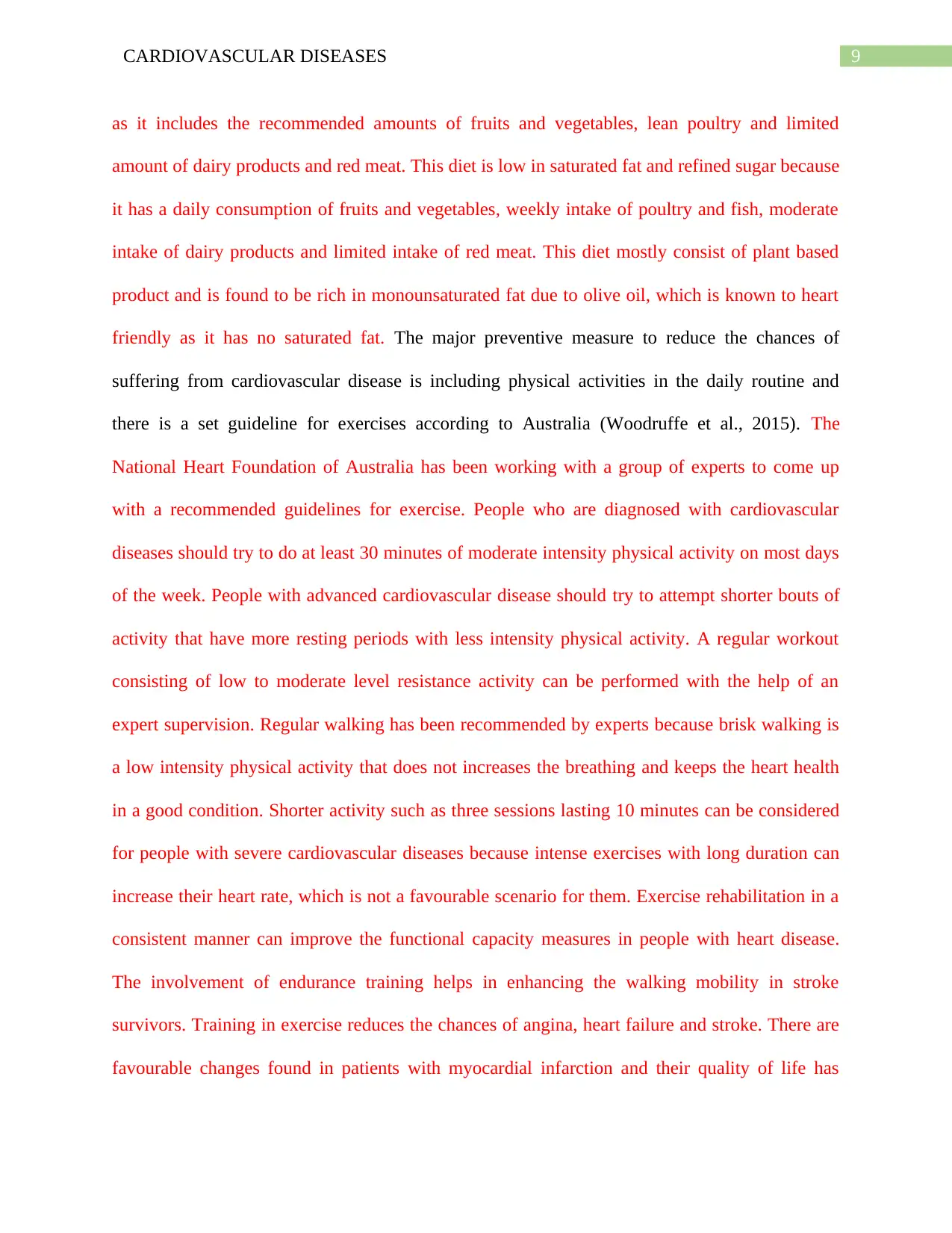
9CARDIOVASCULAR DISEASES
as it includes the recommended amounts of fruits and vegetables, lean poultry and limited
amount of dairy products and red meat. This diet is low in saturated fat and refined sugar because
it has a daily consumption of fruits and vegetables, weekly intake of poultry and fish, moderate
intake of dairy products and limited intake of red meat. This diet mostly consist of plant based
product and is found to be rich in monounsaturated fat due to olive oil, which is known to heart
friendly as it has no saturated fat. The major preventive measure to reduce the chances of
suffering from cardiovascular disease is including physical activities in the daily routine and
there is a set guideline for exercises according to Australia (Woodruffe et al., 2015). The
National Heart Foundation of Australia has been working with a group of experts to come up
with a recommended guidelines for exercise. People who are diagnosed with cardiovascular
diseases should try to do at least 30 minutes of moderate intensity physical activity on most days
of the week. People with advanced cardiovascular disease should try to attempt shorter bouts of
activity that have more resting periods with less intensity physical activity. A regular workout
consisting of low to moderate level resistance activity can be performed with the help of an
expert supervision. Regular walking has been recommended by experts because brisk walking is
a low intensity physical activity that does not increases the breathing and keeps the heart health
in a good condition. Shorter activity such as three sessions lasting 10 minutes can be considered
for people with severe cardiovascular diseases because intense exercises with long duration can
increase their heart rate, which is not a favourable scenario for them. Exercise rehabilitation in a
consistent manner can improve the functional capacity measures in people with heart disease.
The involvement of endurance training helps in enhancing the walking mobility in stroke
survivors. Training in exercise reduces the chances of angina, heart failure and stroke. There are
favourable changes found in patients with myocardial infarction and their quality of life has
as it includes the recommended amounts of fruits and vegetables, lean poultry and limited
amount of dairy products and red meat. This diet is low in saturated fat and refined sugar because
it has a daily consumption of fruits and vegetables, weekly intake of poultry and fish, moderate
intake of dairy products and limited intake of red meat. This diet mostly consist of plant based
product and is found to be rich in monounsaturated fat due to olive oil, which is known to heart
friendly as it has no saturated fat. The major preventive measure to reduce the chances of
suffering from cardiovascular disease is including physical activities in the daily routine and
there is a set guideline for exercises according to Australia (Woodruffe et al., 2015). The
National Heart Foundation of Australia has been working with a group of experts to come up
with a recommended guidelines for exercise. People who are diagnosed with cardiovascular
diseases should try to do at least 30 minutes of moderate intensity physical activity on most days
of the week. People with advanced cardiovascular disease should try to attempt shorter bouts of
activity that have more resting periods with less intensity physical activity. A regular workout
consisting of low to moderate level resistance activity can be performed with the help of an
expert supervision. Regular walking has been recommended by experts because brisk walking is
a low intensity physical activity that does not increases the breathing and keeps the heart health
in a good condition. Shorter activity such as three sessions lasting 10 minutes can be considered
for people with severe cardiovascular diseases because intense exercises with long duration can
increase their heart rate, which is not a favourable scenario for them. Exercise rehabilitation in a
consistent manner can improve the functional capacity measures in people with heart disease.
The involvement of endurance training helps in enhancing the walking mobility in stroke
survivors. Training in exercise reduces the chances of angina, heart failure and stroke. There are
favourable changes found in patients with myocardial infarction and their quality of life has
Paraphrase This Document
Need a fresh take? Get an instant paraphrase of this document with our AI Paraphraser
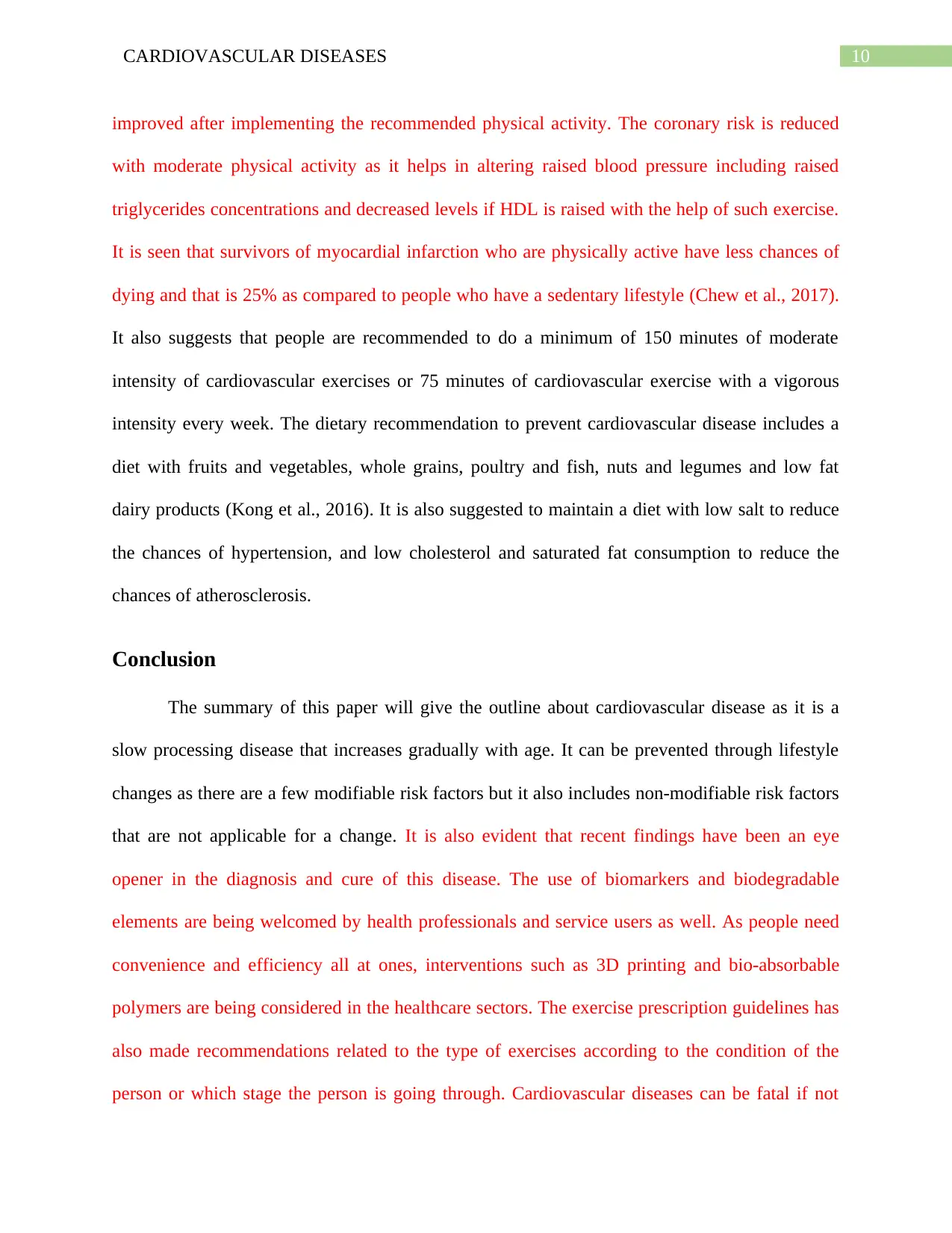
10CARDIOVASCULAR DISEASES
improved after implementing the recommended physical activity. The coronary risk is reduced
with moderate physical activity as it helps in altering raised blood pressure including raised
triglycerides concentrations and decreased levels if HDL is raised with the help of such exercise.
It is seen that survivors of myocardial infarction who are physically active have less chances of
dying and that is 25% as compared to people who have a sedentary lifestyle (Chew et al., 2017).
It also suggests that people are recommended to do a minimum of 150 minutes of moderate
intensity of cardiovascular exercises or 75 minutes of cardiovascular exercise with a vigorous
intensity every week. The dietary recommendation to prevent cardiovascular disease includes a
diet with fruits and vegetables, whole grains, poultry and fish, nuts and legumes and low fat
dairy products (Kong et al., 2016). It is also suggested to maintain a diet with low salt to reduce
the chances of hypertension, and low cholesterol and saturated fat consumption to reduce the
chances of atherosclerosis.
Conclusion
The summary of this paper will give the outline about cardiovascular disease as it is a
slow processing disease that increases gradually with age. It can be prevented through lifestyle
changes as there are a few modifiable risk factors but it also includes non-modifiable risk factors
that are not applicable for a change. It is also evident that recent findings have been an eye
opener in the diagnosis and cure of this disease. The use of biomarkers and biodegradable
elements are being welcomed by health professionals and service users as well. As people need
convenience and efficiency all at ones, interventions such as 3D printing and bio-absorbable
polymers are being considered in the healthcare sectors. The exercise prescription guidelines has
also made recommendations related to the type of exercises according to the condition of the
person or which stage the person is going through. Cardiovascular diseases can be fatal if not
improved after implementing the recommended physical activity. The coronary risk is reduced
with moderate physical activity as it helps in altering raised blood pressure including raised
triglycerides concentrations and decreased levels if HDL is raised with the help of such exercise.
It is seen that survivors of myocardial infarction who are physically active have less chances of
dying and that is 25% as compared to people who have a sedentary lifestyle (Chew et al., 2017).
It also suggests that people are recommended to do a minimum of 150 minutes of moderate
intensity of cardiovascular exercises or 75 minutes of cardiovascular exercise with a vigorous
intensity every week. The dietary recommendation to prevent cardiovascular disease includes a
diet with fruits and vegetables, whole grains, poultry and fish, nuts and legumes and low fat
dairy products (Kong et al., 2016). It is also suggested to maintain a diet with low salt to reduce
the chances of hypertension, and low cholesterol and saturated fat consumption to reduce the
chances of atherosclerosis.
Conclusion
The summary of this paper will give the outline about cardiovascular disease as it is a
slow processing disease that increases gradually with age. It can be prevented through lifestyle
changes as there are a few modifiable risk factors but it also includes non-modifiable risk factors
that are not applicable for a change. It is also evident that recent findings have been an eye
opener in the diagnosis and cure of this disease. The use of biomarkers and biodegradable
elements are being welcomed by health professionals and service users as well. As people need
convenience and efficiency all at ones, interventions such as 3D printing and bio-absorbable
polymers are being considered in the healthcare sectors. The exercise prescription guidelines has
also made recommendations related to the type of exercises according to the condition of the
person or which stage the person is going through. Cardiovascular diseases can be fatal if not

11CARDIOVASCULAR DISEASES
maintained or treated with time. However, it can be maintained with the help of lifestyle
changes. Several forms of treatment have been invented that can help in curing the disease. The
dietary guidelines have come up with several standards to educate people about the prevention of
this disease.
maintained or treated with time. However, it can be maintained with the help of lifestyle
changes. Several forms of treatment have been invented that can help in curing the disease. The
dietary guidelines have come up with several standards to educate people about the prevention of
this disease.
⊘ This is a preview!⊘
Do you want full access?
Subscribe today to unlock all pages.

Trusted by 1+ million students worldwide
1 out of 16
Related Documents
Your All-in-One AI-Powered Toolkit for Academic Success.
+13062052269
info@desklib.com
Available 24*7 on WhatsApp / Email
![[object Object]](/_next/static/media/star-bottom.7253800d.svg)
Unlock your academic potential
Copyright © 2020–2025 A2Z Services. All Rights Reserved. Developed and managed by ZUCOL.





